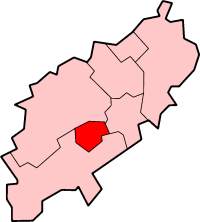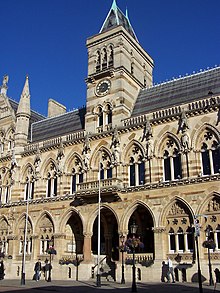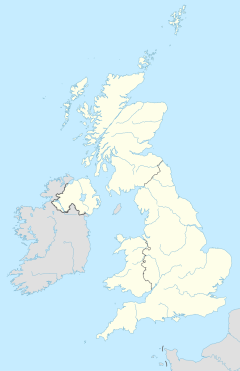Northampton
|
Borough of Northampton Northampton |
||
|---|---|---|
| Coordinates | 52 ° 14 ′ N , 0 ° 54 ′ W | |
|
|
||
| Residents | 214,566 (as of 2012) | |
| surface | 80.76 km² (31.18 mi² ) | |
| Population density: | 2657 inhabitants per km² | |
| administration | ||
| Post town | NORTHAMPTON | |
| ZIP code section | NN1 - NN6 | |
| prefix | 01604 | |
| Shire county | Northamptonshire | |
| Ceremonial county | Northamptonshire | |
| District | Northampton | |
| ONS code | 34UF | |
| Website: www.northampton.gov.uk | ||


Northampton [ nɔːˈθæmptən ] is a town and district in central England on the River Nene and also the administrative seat (county town) of Northamptonshire . The city is about 100 kilometers north of London .
Northampton has always been an industrial city, in particular shoes and other leather goods have been produced. In the meantime, mechanical engineering and service companies have also appeared.
Northampton is the most densely populated district in all of England and yet is not an independent city district ( Unitary Authority ). The city council claims that Northampton is the largest city in England that does not have the status of a City , a London Borough or a Metropolitan Borough . Medway and Milton Keynes , while they could boast about it, are not seen as separate cities.
history
Archaeological excavations in the Northampton area have shown settlement as early as the Iron Age and the time of the Roman occupation. The first arable farmers can be documented from the 7th century. In the 8th century Northampton, originally called "Ham tun" by the Anglo-Saxon settlers, became an administrative seat within the Kingdom of Mercia . The first written mention of the name Horthamton comes from the year 914.
The city became important in the 11th century when the Normans built city walls, Northampton Castle and the parish church of All Saints in Northampton. In the middle of the 13th century Northampton had its own university for a few years , but it was dissolved again under pressure from Cambridge and Oxford. The Agreement of Edinburgh and Northampton , also known as the "Treaty of Northampton", was ratified by the English Parliament on May 3, 1328 . In 1460, during the Wars of the Roses , King Henry VI. Captured at Northampton by supporters of the House of York .
Northampton supported the parliamentarians during the English Civil War . Therefore, the city walls and the castle were razed as punishment on the orders of King Charles II . Today the station stands on the remains of the castle. It is therefore called "Northampton Castle Station".
In 1675 the city was destroyed by a great fire and finally rebuilt according to the drawing board. The now Anglican All Saints parish church was rebuilt in the baroque style .
In the 19th century, Northampton became known as a haven of political radicalism when Charles Bradlaugh was elected local MP on multiple occasions. After the emancipation of Catholics and the immigration of Irish industrial workers, St. Mary's Cathedral was built for the Catholic diocese of Northampton , founded in 1850 . In the 1960s, the city became a new town, causing the population to skyrocket. The city was then also connected to the motorway network.
| Northamptons town twinning | ||||
|---|---|---|---|---|
| Poitiers |
|
April 20, 1979 | ||
| Marburg |
|
1992 | ||
Leisure and culture
The city is known for its numerous parks . On the outskirts of the city there is an amusement park (Billing Aquadrome) with an attached campsite and marina.
In addition to a modern shopping arcade, Northampton is said to have the largest marketplace in Britain (from 1235).
The Northampton Saints rugby union club plays at Franklin's Gardens .
Every year on the last weekend in July there has been the Twinfest since the 2010s , a RockPop music festival based on the model of the Marburg MaNo Festival, which has been running since 1986 . In addition to many local bands and singer-songwriters, a small selection of bands from the partner cities of Marburg and Poitiers play there .
Buildings
- Northampton Castle , 11th century
- All Saints main Anglican parish church , origin around 1100, new baroque building after the fire of 1675
- Roman Catholic St. Mary's Cathedral , started in 1844, today's shape in 1955
- Northampton Guildhall, 1861–64
- Express lift tower , 1980–82
- Sixfields Stadium , 1994
sons and daughters of the town
- Thomas Dudley (1576–1653), colonial magistrate and multiple governor of the Massachusetts Bay Colony
- Anne Bradstreet (1612–1672), first English-language poet whose works were published
- Charles Fleetwood (1618–1692), soldier and politician; from 1652 to 1655 he was Lord Deputy of Ireland
- Samuel Parker (1640–1687), theologian and Bishop of Oxford
- Ernest Scott (1867–1939), historian, journalist, author and theosophist
- John Henry Brookes (1891–1975), educator, university professor and holder of the Order of the British Empire
- Albert Ingham (1900–1967), mathematician who dealt with analytical number theory and analysis
- Edmund Rubbra (1901–1986), composer
- William Alwyn (1905–1985), composer
- Francis Crick (1916–2004), scientist and Nobel Prize winner
- Robert Adams (1917–1984), sculptor
- Malcolm Arnold (1921-2006), composer
- Jack Sears (1930-2016), racing car driver
- Jonathan Adams (1931-2005), actor
- Nanette Newman (* 1934), actress and writer
- Robert Grange (1938-2018), British actor
- Mike Berry (1942-2010), singer and actor
- Martin Drew (1944-2010), jazz drummer
- Roger Goody (* 1944), biochemist
- Will Alsop (1947–2018), architect
- Alan Moore (* 1953), comic book writer
- Peter Murphy (born 1957), musician
- Neill Archer (* 1961), tenor
- Colin Hood (* 1961), systems engineering expert
- Mark Haddon (* 1962), writer
- Jacqui Dankworth (born 1963), jazz singer
- Marc Warren (born 1967), actor
- Jeremy Wooding (* 1969), film director, screenwriter and film producer
- Tim Minchin (* 1975), Australian comedian, actor and musician
- Shaun Murphy (* 1982), professional snooker player
- Matt Smith (born 1982), actor
- Karl Darlow (* 1990), football player
- Sophie Turner (* 1996), actress
- Maps (James Chapman), artist, electric popper
Web links
Individual evidence
- ↑ Population of England and Wales on June 30, 2012 ( ZIP ; 832 kB)
- ^ Tim Lambert: A Brief History of Northampton
- ↑ Twinfest website , accessed on March 18, 2019

